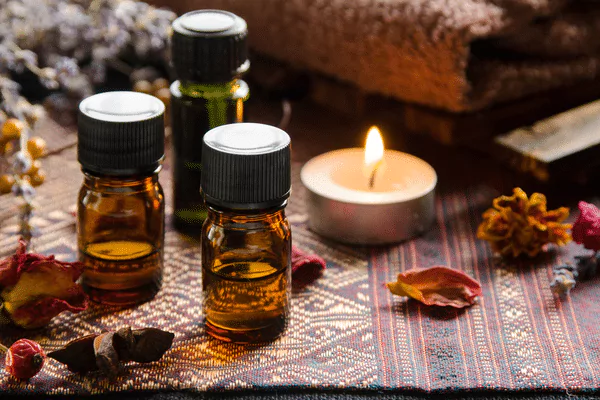
Also called “false sandalwood,” Buddha wood essential oil is sometimes used as a substitute for sandalwood, though the scent is somewhat different, and the oil comes from a different tree.
The Story of a Small Australian Tree
Whereas sandalwood essential oil comes from the sandalwood tree (Santalum album), Buddha wood is from a large shrub or small tree in the figwort family (Eremophila mitchellii).
More often shrub-like than tree, Eremophila mitchellii or “bastard sandalwood” is evergreen and can grow up to 30 feet tall, though it’s most often found at about 10 feet. The word “Eremophila” comes from the Greek eremos, which means “desert,” and from phileo, which means love, and indeed, these plants do seem to love a desert climate.
The leaves are long and thin, and give off an aroma when crushed. The flowers are a pretty white or cream and tubular shaped with spots on the throat. The plant as a whole is rather sticky because of the resin present in the leaves and branches. It grows so easily that it’s seen as a pest on many grazing lands in Australia, and is not permitted in Western Australia. Therefore, it’s rarely cultivated and the oil is most often wildcrafted.
That lovely essential oil is steam distilled from the heartwood and bark, with a scent that has been called rich, rugged, calming, woody, smoky, resinous, and complex. It’s said to have a “lighter side,” which works well in perfumes without overpowering other notes. The main constituents are eremophilone, 2-hydroxy-eremophilone, and 2-hydroxy-2-dihydro eremophilone, and its said to be somewhat similar to components of vetiver and agarwood.
Its woody, mossy and slightly smoky scent, makes it popular as a meditative oil and it’s also frequently used as a base note in perfumes.
In addition to its grounding and calming abilities in aromatherapy, this oil also has some pretty impressive health benefits.
Health Benefits of Buddha Wood Essential Oil
The indigenous people of Australia were said to have used the Buddha Wood plant for its antibacterial qualities and to treat cuts and sores, as well as rheumatitis. Indeed, we know that the oil has antimicrobial properties and is active against certain types of bacteria like Staphylococcus aureus, Salmonella typhimurium and Candida albicans.
Applied topically, the oil is also said to be a good anti-inflammatory, particularly helpful for aches and pains and for sore muscles and joints. It works great in massage oils, as its analgesic effects can help add a pain-relieving quality.
Caution is recommended with any internal use, however, because the oil is rich in ketones, which in some cases, can be toxic, particularly at higher levels or with long-term use.
Aromatherapy Benefits of Buddha Wood Essential Oil
Where this oil really shines is in its use in aromatherapy and perfumes. Here, it is coveted as the perfect meditative oil, as it is said to inspire peace and mindfulness, and to provide a pleasant, woody aroma for fragrances. Buddha wood is also said to help center the emotions and to encourage calm and relaxation.
Some ideas for Buddha wood oil:
- Add to massage oils to soothe sore muscles
- Add a few drops to the bath for a nice scent and a subtle anti-bacterial property
- Use as a base note when creating your own fragrances
- Use in a spritz for clearing energies
- Use in a diffuser for a grounding meditation
- Inhale 15-30 minutes before bed to encourage a restful sleep
This oil also blends well with the following:
- Cedarwood
- Peru Balsam
- Lavender
- Neroli
- Patchouli
- Rose
- Sandalwood
- Ylang ylang
Do you use Buddha wood oil in your aromatherapy applications? Please share any ideas you may have.
The following blog post Why You Should Add Buddha Wood Essential Oil to Your Massages was originally published on www.annmariegianni.com
No comments:
Post a Comment